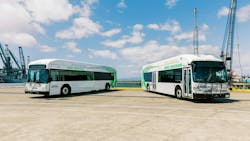AC Transit’s Zero-Emissions Journey: The 5x5 Study and Beyond
The public transit industry is working to eliminate its greenhouse gas emissions one bus at a time. Public transit systems across the U.S. are embracing the challenge of reducing their carbon footprints while providing efficient, reliable service to communities. Among the leaders in this transition is the Alameda-Contra Costa Transit District (AC Transit), who has been on the road to implementing a zero-emissions fleet since 1999. For the past 25 years, the agency’s mission has focused on improving air quality within its most densely populated service areas.
The need to improve air quality in California’s Bay Area, particularly in the East Bay, pushed the state into action as many cities faced high levels of nitrogen oxides (NOx), particulate matter and other harmful pollutants commonly associated with diesel-powered vehicles. Diesel buses, which made up the majority of AC Transit’s fleet at the time, were a major source of these pollutants.
AC Transit’s mission to explore cleaner buses to better serve its community was fortified through the California Air Resources Board’s (CARB) adoption of the Innovative Clean Transit (ICT) regulation in 2017, which mandated a state-wide gradual transition to a 100 percent zero-emission fleet by 2040.
Setting standards
With the surge of national interest in zero-emission vehicles, charging infrastructure and proper maintenance methods, AC Transit worked to set the standard of reference for agencies working to adhere to state mandates. The agency wanted to explore which buses had the best propulsion system.
In 2021, AC Transit launched its Zero Emission Transit Bus Technology Analysis (ZETBTA), a comprehensive research and planning project, in partnership with Stanford University, aiming to transform its transit network and develop a better understanding of how to effectively integrate zero-emission buses (ZEBs) into its existing service schedules, rather than modifying schedules to fit the buses.
Setting it up
The ZETBTA study tested the performance and feasibility of integrating fuel-cell electric buses (FCEB), battery-electric buses (BEB), legacy fuel cells buses (FC) and diesel hybrid buses. These four technologies were compared to a conventional diesel bus as a control fleet.
The study called for five of each engine propulsion systems to operate throughout the agency’s service areas, earning the nickname the ”5X5 Study.”
Stanford students and faculty analyzed the performance data collected during the study, focusing on range, operational efficiency and maintenance needs.
“We wanted to partner with a university renowned for energy, environmental, and sustainable sciences that could do a deeper dive analysis into the environmental impacts and components of transit bus operations,” said AC Transit COO Salvador Llamas in reference to the 5x5 study’s focus on reducing public transit’s carbon footprint. “We also wanted to validate our formulas and the resulting data to ensure that there was no bias, and a clarification on accuracy of the data itself.”
AC Transit says these real-world simulations helped to develop a better idea of the projected long-term performance and cost effectiveness of different zero-emission technologies. These models took into account factors such as energy consumption, vehicle lifespan, total cost of ownership and maintenance requirements. The simulations helped predict how these buses would perform over time, both in terms of operational efficiency and environmental impact.
The process
The 5x5 Study’s results were released in four complete volumes that detailed AC Transit’s evolving processes and discoveries along the way. AC Transit’s approach included:
Data collection and analysis: The study started with a comprehensive review of existing routes, ridership patterns and operational data to understand where improvements were needed most.
Stakeholder engagement: Community feedback was gathered through meetings and surveys to ensure the study aligned with the needs of riders and the broader community.
Pilot programs: As part of the study, pilot projects were rolled out to test specific changes, such as new route configurations and higher bus frequencies.
Strategic recommendations: The final phase of the study resulted in the presentation of recommendations that would help improve routes, with a focus on sustainable transit and the gradual adoption of ZEBs.
This process was marked by a strong emphasis on collaboration, data-driven decision-making and a commitment to addressing both immediate and long-term needs of the community. Each volume of the study helped to establish a better picture of what AC Transit’s system needed out of the buses it was testing.
Results and applications
AC Transit’s strategic recommendations from the fourth and final volume of the 5x5 study summarized its findings over the past two years, highlighting fleet availability, fuel efficiency levels and the mileage each type of bus was able to travel before requiring maintenance.
Fleet availability
As part of the 5X5 Study, AC Transit measured the fleet availability for morning pull out. In the third volume of the study (from July 2021 to December 2021), it was found that FCEBs were available 65 percent of the time while BEBs were available 60 percent of the time. The legacy FC fleet was considered available for operation 50 percent during that period, and diesel hybrid buses were available for service 63 percent of the time. Diesel buses came in at a reliable availability of 90 percent.
In comparison, the final volume of the study (between January 2022 through June 2022) found the FCEB fleet was available for 78 percent of the time and had one bus account for almost half of the days due to a Vanner DC converter issue.
The BEB fleet showed a 66 percent availability, with more than half of the total days related to a retrofit of the charger cabling and programming by the original equipment manufacturer (OEM). The legacy fuel cell fleet, affected by low output power of the fuel cell of several units, operated at an average availability of 57 percent. The hybrid fleet came in at an average of 51 percent due to two engine failures and supply chain issues.
The report also found the diesel fleet displayed a higher average of availability, with over 89 percent of buses did not experience a pattern of chronic issues. AC Transit notes the overall availability of all fleets continues to be impacted by supply chain delays.
Mileage and fuel efficiency
The study showed the FCEB can travel 300 miles with one fill that takes up to six to eight minutes to refuel while the BEB can only travel 170 miles before needing to recharge for three to four hours. Llamas says this is an operational complication that has led to the agency’s decision to move forward with a zero-emissions plan that calls for 70 percent of its fleet to become FCEB and 30 percent BEB at each one of its properties.
According to Llamas, the decision was made after the federal government put out a requirement for a transition plan to be announced in order for AC Transit to apply for loans or grants.
To change and grow
AC Transit plans to replace vehicles at the end of their useful life under the Transit Asset Management (TAM) Plan, guided by these ZEB transition principles that align with federal and state regulations and transit district board policy:
- Replace the fleet per FTA-mandated TAM Plan targets.
- Prioritize ZEB deployment per the Clean Corridors Plan.
- Procure ZEBs based on technology and service needs.
- Deploy sustainable ZEB technology.
- Achieve the 2040 Innovative Clean Transit goal.
The agency is also working on improving the infrastructure needed to support a BEB fleet by installing charging stations at key depots. The agency’s newest installation features the ChargePoint Express Plus, which is configured with one charger connected to two dispensers and allows the agency to charge its buses faster and efficiently.
These new updates to AC Transit’s bus fleet require employees to keep pace with changing technologies. AC Transit mechanics and other support employees are put through a workforce development program that focuses on cultivating an understanding of common issues ZEBs experience based on the OEM.
AC Transit is working to enhance this program through its newly launched Zero Emission Bus University (ZEBU), which features virtual training courses. One course focuses on the Zero Voltage Test, which AC Transit says enables mechanics to practice the necessary steps to ensure a vehicle is in a safe state before performing maintenance. The agency wants to provide a safer opportunity for mechanics to become familiar with the process ahead of time, preparing them for when the procedure is needed.
“Much of what we do in the zero-emission maintenance environment can pose dangerous risks,” commented AC Transit Media Affairs Manager Robert Lyles. “What we want to do is to remove any risk from those who are training, and the virtual environment allows us to do that.”
AC Transit says its success with its gradual transition to a zero-emissions fleet is owed to a great amount of collaboration, support and the response from the bus and infrastructure manufacturers who are working with the agency to resolve challenges and evolve the technology.
Llamas says that AC Transit’s workforce is empowered by teamwork and ingenuity. “They [employees] have this can-do attitude,” Llamas noted. “When something fails, the easy thing to do is to park it and give it back to the bus manufacturer. Our employees work to figure out how to fix it and make it better, and I think that's what's different about our culture, our workforce and organization.”
About the Author
Eman Abu-Khaled
Associate Editor
Eman Abu-Khaled is a former associate editor with Mass Transit magazine.

